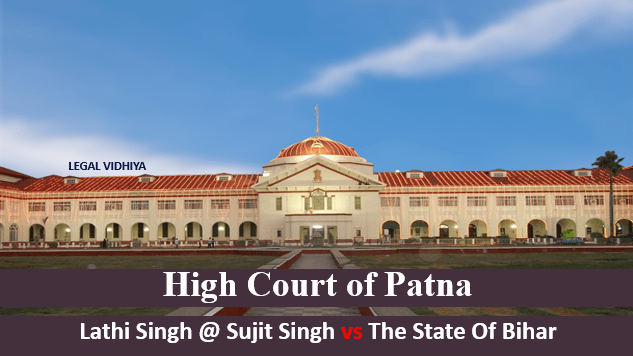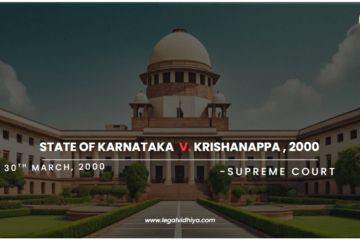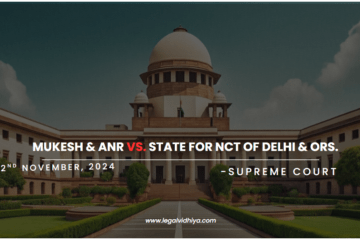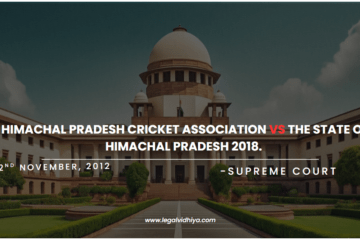
Lathi Singh @ Sujit Singh vs The State Of Bihar
| Case Name: | Lathi Singh @ Sujit Singh vs The State Of Bihar |
| Date of judgment: | 5th August 2010 |
| Court: | Patna High Court |
| Case Type: | Criminal Appeal |
| Case Number: | Death Reference No. 3 of 2008With CR. APPEAL (DB) No.72 of 200 With CR. APPEAL (DB) No.77 of 2008With CR. APPEAL (DB) No.79 of 2008 |
| Appellant: | 1. Lathi Singh @ Sujit Singh 2. Arbind Singh 3. Manoj Singh |
| Respondent: | State of Bihar |
| Bench: | MR. JUSTICE SHYAM KISHORE SHARMA, MR. JUSTICE GOPAL PRASAD |
| Statues Referred: | Section 162 of the Criminal Procedure Code Section 161 of the Criminal Procedure Code Section 145 of the Indian Evidence Act, 1872 Section 154 of the Criminal Procedure Code |
Facts Of the Case:
The case involves three separate appeals and a death reference, which were heard together and are being addressed in this common judgment.
All the appellants in the three appeals were convicted under Sections 302/149 of the Indian Penal Code, as well as Sections 17 of the Criminal Law Amendment Act and 27 of the Arms Act.
They were sentenced to death for their conviction under Section 302/149 of the Indian Penal Code in Session’s Trial No. 174 of 2004. Appellants Arvind Singh and Manoj Singh were additionally convicted under Section 148 of the Indian Penal Code.
The order passed on 1st February 2008 by Shri Om Prakash, Additional District Judge, Fast Track Court, V, Patna, did not award any sentence for the offenses under Sections 148 of the Indian Penal Code, 27 of the Arms Act, and 17 of the Criminal Law Amendment Act in Session’s Trial No. 1074 of 2004.
Therefore, the learned judge submitted the proceeding to this Court for confirmation of the death sentence. This submission has been registered as Death Reference No. 3 of 2008. Each of the convicts has filed a separate appeal against the judgment of conviction and sentence. These appeals are registered as Cr. Appeal (D.B.) No. 72, 77, and 79 of 2008, respectively. Consequently, the death reference and the three appeals were heard collectively and are being addressed in this common judgment.
The case revolves around an incident that occurred on 18th May, 2004, in Paswantola village. During this incident, an unlawful assembly of approximately 60-70 individuals armed with lethal weapons surrounded Paswantola and began indiscriminate firing, resulting in the death of four individuals.
P.W. 11, the informant, provided evidence stating that at the time of the occurrence, he was present in the bamboo club (banswari) along with Naseeb Paswan (P.W. 8), Vijay Paswan (deceased), Sharawan Paswan (deceased), and Udai Paswan (deceased). He witnessed the unlawful assembly and identified several individuals, including Brindra Singh, Arvind Singh, Lathi Singh, Sudhir Singh, and Gajendra Singh, who were armed with rifles and guns.
He further stated that Udai Paswan, who was unable to flee, was shot and killed by the assembly. P.W. 11 also mentioned that he saw Naga Paswan and Bhim Paswan working in their fields when Maheshwar, Lallan, and Arvind shot at Naga Paswan, causing him to fall in the Khalihan of Basant Paswan.
He further stated that Arvind hurled a bomb at Naga Paswan, leading to his death. P.W. 11 heard approximately 20-25 sounds of gunfire as the assembly moved northwards, shouting slogans. P.W. 8, another witness, testified that he was present in the bamboo club when the assembly arrived and began firing. He identified Manoj Singh, Lathi Singh, and Arvind Singh as among the individuals who were fired.
Though there was a minor discrepancy in his testimony regarding their weapons, it did not significantly affect their identification as members of the unlawful assembly.
P.W. 10 also supported the prosecution’s case, stating that he witnessed the assembly of 60-70 persons resorting to firing, with Arvind Singh and Lathi Singh among them. He identified these individuals as participants in the firing. P.W. 11, the informant, testified that he had made a statement before the police during the investigation, implicating the appellants.
However, during cross-examination, it was revealed that the investigating officer (P.W. 14) stated that P.W. 11 had not provided certain details in his statement recorded by the police. The defense argued that this omission amounted to a contradiction.
The defense further contended that there were contradictions and omissions in the statements of P.Ws. 8, 10, and 11, which weakened the prosecution’s case. They claimed that the appellants were not properly identified as members of the unlawful assembly resorting to firing.
The trial court examined the evidence presented by the prosecution, including the witness testimonies and the identification of the appellants.
The court noted the discrepancies and omissions but concluded that they were minor in nature and did not significantly impact the overall case against the appellants.
After considering the evidence and arguments presented, the trial court found the appellants guilty and convicted them under Section 302/149 of the Indian Penal Code, which pertains to murder committed by a member of an unlawful assembly. The court sentenced the appellants to death.
Contentions of the Appellant:
The appellant’s counsel argued that the attention of the witness was not drawn to his earlier statement recorded under Section 161 of the Criminal Procedure Code, which is required for contradiction.
It was contended that the witness statements in court differed from their statements in the first information report (fardbeyan), and the investigating officer confirmed that the appellants’ names were not mentioned by the witnesses during the investigation.
The appellant’s counsel pointed out minor contradictions in the evidence of the witnesses, such as discrepancies in their description of the weapons carried by the appellants.
It was argued that the omission of specific details about the appellants’ participation in the fardbeyan should be considered as a contradiction, but the prosecution case still maintained that 60-70 persons came and resorted to firing.
The delay in sending the first information report to the magistrate was raised as a point of contention, suggesting a potential fabrication or manipulation in the prosecution case.
The appellant’s counsel questioned the lack of evidence supporting the claim that a bomb was hurled by one of the appellants, as no remains of the bomb were found at the crime scene.
Lastly, it was contended that the evidence against the appellants only established their participation in the unlawful assembly, guided by mob mentality, and did not qualify as a rarest of rare cases warranting the death penalty.
Contentions of the Prosecution:
The prosecution contended that 60-70 persons formed an unlawful assembly and indiscriminately fired, resulting in the death of four individuals.
The witnesses (P.Ws. 8, 10, and 11) identified the appellants as members of the mob involved in the firing and implicated them in the crime.
The prosecution argued that the witnesses’ identification of the appellants was supported by their presence at the place of occurrence, the fardbeyan (first information report) naming the appellants, and the subsequent detailed statements given in court.
The participation of the appellants in the unlawful assembly and their resorting to firing was deemed to be established by the prosecution’s evidence.
The prosecution relied on the inquest report and post-mortem reports to establish the death of the four individuals due to firearm injuries.
It was asserted that the minor discrepancies or omissions in the witnesses’ statements did not significantly impact their evidence’s overall reliability and credibility.
The prosecution maintained that the delay in sending the first information report to the magistrate did not undermine the credibility of the case unless it could be shown that the delay resulted in prejudice or manipulation.
The prosecution argued that the evidence against the appellants, combined with the nature of their participation in the unlawful assembly, warranted the charges under Section 302/149 of the Indian Penal Code.
The prosecution acknowledged that the case did not meet the criteria for the “rarest of rare” cases deserving the death penalty, suggesting that the sentence be modified to imprisonment for life.
Judgement:
The Death Reference is answered in the negative, and the Criminal Appeals are dismissed with the modification in the sentence.
Based on the entire evidence presented, including the establishment of the presence of 60-70 persons resorting to firing, the deaths of four individuals confirmed by inquest and post mortem reports, and the identification and participation of the appellants in the unlawful assembly, the prosecution has successfully proven the charges against the appellants under Section 302/149 of the Indian Penal Code.
However, regarding the sentencing of the appellants, it is noted that there is no evidence indicating that the appellants played a leading or exceptional role in the incident. The evidence suggests that they were members of the unlawful assembly acting under the influence of mob mentality.
Therefore, considering the circumstances, it is not deemed a case of the rarest of rare, warranting the death penalty. Instead, the sentence is modified to life imprisonment for the appellants.
Conclusion:
In this case, the judgment resulted in the dismissal of the appeals filed by the appellants. The court found that the prosecution had successfully established the participation of the appellants in an unlawful assembly that resorted to firing, causing the death of four individuals. However, considering that the evidence only demonstrated their involvement in the mob mentality and not as the principal perpetrators, the court reduced the appellants’ sentence from death to life imprisonment. This conclusion was reached after a thorough examination of the facts, witness testimonies, and relevant legal principles.
Written by Shobhita Shrivastava intern under legal vidhiya.




0 Comments